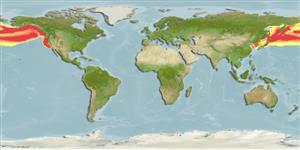Teleostei (teleosts) >
Scombriformes (Mackerels) >
Icosteidae (Ragfish)
Etymology: Icosteus: Greek, eikoo = to sag, to bend something that is soft + Greek, osteon = bone.
Environment: milieu / climate zone / depth range / distribution range
Ecology
Marine; bathypelagic; depth range 0 - 1420 m (Ref. 50550), usually 18 - 732 m (Ref. 2850). Deep-water; 66°N - 32°N
North Pacific: Japan to southeastern Alaska and to Point Loma, southern California, USA.
Size / Weight / Age
Maturity: Lm ? range ? - ? cm
Max length : 213 cm TL male/unsexed; (Ref. 2850)
Dorsal spines (total): 0; Dorsal soft rays (total): 52 - 55; Anal spines: 0; Anal soft rays: 34 - 40. Pectorals rounded, pedunculate (Ref. 6885). Generally of a chocolate color (Ref. 6885). Young more robust, with an expanded and rounded caudal fin, 5 pelvic rays, and a brown and yellow irregularly blotched with faint purple color, dusky on fins (Ref. 6885).
Adults occur near bottom; juveniles in shallow water or offshore near the surface (Ref. 50277). Feeds on jellyfish (Ref. 50277), fishes and squids (Ref. 2850), as well as octopuses (Ref. 4525).
Eschmeyer, W.N., E.S. Herald and H. Hammann, 1983. A field guide to Pacific coast fishes of North America. Boston (MA, USA): Houghton Mifflin Company. xii+336 p. (Ref. 2850)
IUCN Red List Status (Ref. 130435: Version 2024-1)
Threat to humans
Harmless
Human uses
Fisheries: bycatch
Tools
Special reports
Download XML
Internet sources
Estimates based on models
Preferred temperature (Ref.
123201): 2 - 14.1, mean 6.2 °C (based on 1370 cells).
Phylogenetic diversity index (Ref.
82804): PD
50 = 1.5000 [Uniqueness, from 0.5 = low to 2.0 = high].
Bayesian length-weight: a=0.01995 (0.00906 - 0.04395), b=3.01 (2.83 - 3.19), in cm total length, based on all LWR estimates for this body shape (Ref.
93245).
Trophic level (Ref.
69278): 4.5 ±0.57 se; based on food items.
Generation time: 8.5 ( na - na) years. Estimated as median ln(3)/K based on 1
growth studies.
Resilience (Ref.
120179): Low, minimum population doubling time 4.5 - 14 years (K=0.13; Fec=293,000).
Fishing Vulnerability (Ref.
59153): High to very high vulnerability (71 of 100).
